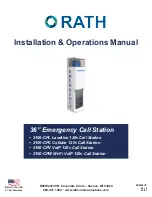
106
Te
mplat
e
G
o
, V
e
rs
ion 1
, 01.
07
.2
014
/ M
odu
leV
e
rs
ion 1
.0
Web configurator
Gigaset S850A GO / LUG GR en / A31008-M2625-T101-1-8U19 / settings_web-conf.fm / 6/4/15
emergency numbers. If the VoIP connection is deleted from the configuration, the emergency
call can no longer be made.
If no emergency numbers are set by default, you should define dialling plans for emergency
numbers yourself and assign them to a connection that you know supports emergency calls.
Access codes – dialling plans when connecting to a PABX
If your phone is connected to a PABX, you may have to enter an access code for external calls
(outside line code, e. g. "0").
Save one access code each for fixed line network and VoIP calls and specify when the phone
numbers should be automatically prefixed with the digits.
These settings are available in the
Access Code
area on the web page:
¤
Settings
Telephony
Dialling Plans
Local area codes – dialling plans for local calls using VoIP
If you use VoIP to make a call to the fixed line network, you may also have to dial the area code
for local calls (depending on the provider). You can avoid having to enter your own local area
code by entering the full area code (with the international code) for the location where you are
using the phone in the phone configuration and activating the
Predial area code for local calls
via VoIP
option.
These settings are available in the
Area Codes
area on the web page:
¤
Settings
Management
Local Settings
Special settings for Internet telephony
Activating Call Forwarding for VoIP connections
The settings for Call Forwarding are on the web page:
¤
Settings
Telephony
Call Divert
You can divert calls to your VoIP connections and to your Gigaset.net number.
You can divert calls to your VoIP connections to any external number (VoIP, fixed line network or
mobile number). Call Forwarding takes place via VoIP.
You can divert calls to your Gigaset.net number within the Gigaset.net, i. e. to another
Gigaset.net number.
Setting DTMF signalling for VoIP
You can change the settings for DTMF signalling in the
DTMF over VoIP Connections
area on the
web page:
¤
Settings
Telephony
Advanced VoIP Settings
DTMF signalling is required, for example, for querying and controlling certain network
mailboxes via digit codes or for remote operation of a local answer machine.
To send DTMF signals via VoIP you must first define how key codes should be converted into and
sent as DTMF signals: as audible information via the speech channel or as an "SIP Info" message.
Ask your provider which type of DTMF transmission it supports.
You can configure your phone in such a way that it attempts with each call to set the most
suitable DTMF signalling for the current codec (
Automatic)
.
















































